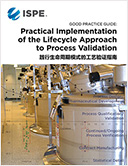
Published: November 2011
Pages: 232
Product Realization using QbD: Illustrative Example (PQLI® Guide Part 2) presents the small molecule case study developed by the ISPE PQLI® teams. This case study provides details of the application of the approaches to product and process understanding using quality risk management. Part 2 also refers to the many case studies in the public domain and uses ICH guidelines Q8 (R2), Q9, and Q10, together with other relevant ICH guidelines.
购买链接:https://ispeshanghai.glueup.cn/event/%e6%8c%87%e5%8d%97%e8%b4%ad%e4%b9%b0-guidance-purchase-42603/
ISPE Good Practice Guide: 践行生命周期模式的工艺验证指南

Published: March 2019
Pages: 208
Guide contributor (co-lead) Robert Beall, PMP, ProPharma Group, shares why process validation is an essential part of the pharma industry and how you'll benefit from the ISPE Good Practice Guide: Practical Implementation of the Lifecycle Approach to Process Validation.
The shift in process validation from a one-time event to the product lifecycle approach expected by most global markets has led to significant changes in validation practices. The science and risk-based approach combines product development knowledge with a structured process performance and product quality monitoring system to provide for validation throughout the product lifecycle.
In today's pharmaceutical industry, process validation relies on information and knowledge from product development activities to ensure patient requirements are translated into product attributes. A key to success is establishing a comprehensive science-based process design that focuses on understanding sources of variability. Translating the sources of variability into a well-designed control strategy, that reliably ensures a product's attributes are attained, may help achieve robust product realization.
Covering a wide variety of manufacturing types, the ISPE Good Practice Guide: Practical Implementation of the Lifecycle Approach to Process Validation is a reference of technical and scientific detail to help organizations conduct process validation from scientifically sound development to robust reliable processes. It is intended to assist companies in understanding the application of global regulatory validation requirements by providing step-by-step implementation approaches to PV and leveraging process understanding to promote best practices. The use of statistical rationales within the different stages of the process validation lifecycle is explained. Case studies demonstrating the benefits of some of the Guide's practices in action are also included.
Discussion Papers
Check out these process validation discussion papers that promote discussion and create awareness on new or emerging topics. The papers often state a problem provide the tentative exploration of solutions and options, and may suggest potential next steps.
- Process Validation in Context of Small Molecule DS and DP Continuous Mfg Processes
- Process Validation Lifecycle Implementation for Existing Products
购买链接:https://ispeshanghai.glueup.cn/event/%e6%8c%87%e5%8d%97%e8%b4%ad%e4%b9%b0-guidance-purchase-42603/